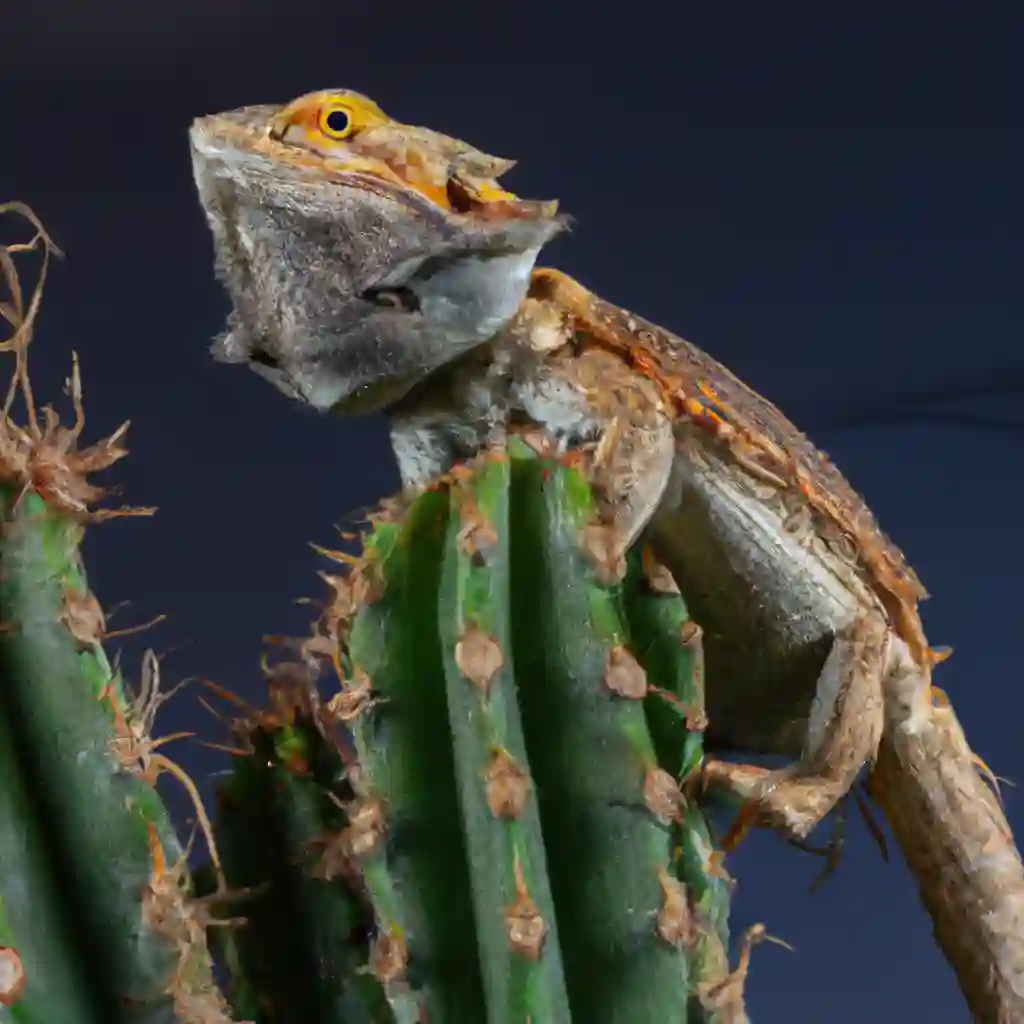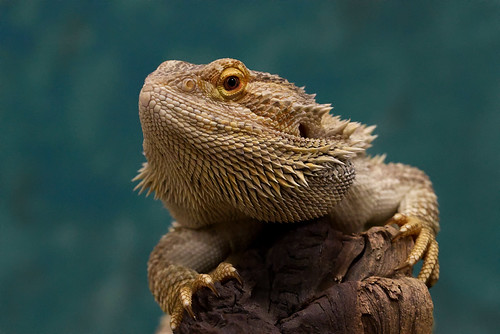Yes, Bearded dragons have several natural predators in the wild, including snakes, birds, dingoes, goannas, and crocodiles. Foxes, feral cats, and wild dogs like dingoes are also known to prey on bearded dragons.
Hawks are the main predator of bearded dragons, but these lizards have a unique defense mechanism where they can sense the change in light from the hawk’s shadow and run away.
Bearded dragons are also known to puff up their bodies and display their “beard” when they feel threatened, which can scare off some predators. However, in captivity, bearded dragons have no natural predators.
Bearded dragons are mainly preyed upon by birds, goannas, snakes, dingoes, feral cats, and foxes in the wild. While some of these predators are native to Australia, others, like feral cats and foxes, are introduced species.
In order to protect bearded dragons, it is important to understand the threats posed by each of these predators and take steps to minimize the risk of predation.
What Are the Natural Predators of Bearded Dragons?
Bearded dragons in the wild have several predators that they must be wary of, including goannas, snakes, and other animals. Goannas, for example, are monitor lizards that are found in the same habitats that bearded dragons inhabit and can easily overpower and devour a bearded dragon.
Similarly, snakes are also a common predator of bearded dragons, as they can quickly catch and consume them.
Types of Bearded Dragon Predators
Transitioning from the previous section, we will now explore the types of bearded dragon predators that exist in the wild. It is important to be aware of these predators as they are known to attack bearded dragons.
Bearded dragons have a few natural predators, including goannas, snakes, and dingoes. Feral cats and foxes can also pose a threat. These predators are all special in their own way and can be dangerous to bearded dragons. Let’s take a closer look at the types of bearded dragon predators.
- Goannas:
- Goannas are predatory lizards that are known for their sharp claws and powerful bites.
- They can track and hunt bearded dragons, making them a formidable predator.
- Goannas may attack a bearded dragon if it is not careful or if it is in close proximity to them.
- Snakes:
- Snakes are a very common predator of bearded dragons.
- They may attack a bearded dragon if it is too close to their territory or if they are feeling threatened.
- Snakes have a deadly bite and can kill a bearded dragon in a short amount of time.
- Dingoes:
- Dingoes are wild canines that can be found in Australia.
- They may attack a bearded dragon if it is too close to their territory, or if they are feeling threatened.
- Dingoes have powerful jaws and can easily kill a bearded dragon if given the chance.
Bearded dragons must be aware of these predators if they are to survive in the wild. Predators such as goannas, snakes, and dingoes can prove to be deadly if a bearded dragon is not careful. It is important to be aware of their presence and take the necessary precautions to ensure the safety of the bearded dragon.
Goannas as Predators
After discussing the many types of predators that threaten bearded dragons, it is important to look more closely at some of the most common predators. Goannas, snakes, and even dingoes can be a threat to these reptiles. Below, we will take a closer look at how goannas can be a threat to bearded dragons in the wild.
- Goannas as Predators
- Goannas, also known as monitor lizards, are a common predator of bearded dragons.
- These large lizards can reach lengths of up to 3.3 feet and can be found throughout Australia and the surrounding areas.
Goannas are opportunistic hunters and will take advantage of any opportunity to hunt and consume food. In the case of bearded dragons, they are very vulnerable while basking in the sun.
Goannas will often take advantage of this and hunt them for food. Bearded dragons must be aware of their surroundings, as a goanna could be lurking nearby.
How Do Bearded Dragons Avoid Predators?
Bearded dragons have evolved several forms of defense to avoid predators, such as camouflage, biting, and hiding. Camouflage helps them blend in with their natural environment, while their sharp teeth are used to deter predators when needed. Finally, they have the ability to take refuge in burrows or under rocks in order to remain hidden.
Camouflage
Bearded dragons are equipped with several strategies for avoiding predators. One of the most common methods is camouflage. By blending into their natural environments, these reptiles can remain hidden from potential predators. In this section, we’ll dive into how bearded dragons use camouflage to stay safe.
- Bearded dragons have adapted to their environment over time, making their colors and patterns blend seamlessly into the surrounding landscape.
- They come in a variety of colors and patterns, such as red, yellow, and orange, making it easy for them to match their surroundings.
- Their skin often has stripes, spots, or blotches, which can help to break up their outline and make them less visible.
- These reptiles also use their behavior to help them blend into the environment.
- They tend to stay very still, which helps them to blend in with objects in their environment.
- They also remain motionless when predators are nearby, as this makes them harder to detect.
Bearded dragons use camouflage to keep themselves safe from predators. By matching their colors and patterns to the environment, and staying still when predators are nearby, bearded dragons are able to remain hidden and avoid becoming a target.
Biting
In addition to camouflage and hiding, bearded dragons also rely on biting to avoid predators. Their strong jaws and sharp teeth are powerful enough to fend off attackers, enabling them to escape dangerous situations.
Bearded dragons are also capable of using their tail as a weapon. The tail is prehensile and can be used to grab or whip predators. Not only are their teeth and tail effective tools for defense, but bearded dragons also have a number of other physical adaptations that help them to evade predators.
- One of these adaptations is their spikes. The spikes on the back of a bearded dragon can serve as a form of intimidation, warning potential predators to stay away.
- Another adaptation is the presence of scent glands located on their sides. These glands secrete a foul-smelling odor when the bearded dragon is threatened, which often deters predators.
- Finally, bearded dragons are also capable of playing dead. When threatened, they may freeze in place, making themselves appear lifeless in an attempt to avoid or deceive predators.
Overall, bearded dragons use a variety of tactics to protect themselves from predators. From using their teeth and tails to employing their spikes and scent glands, these reptiles are well-equipped to fend off danger and survive in the wild.
What Can You Do to Protect Your Bearded Dragon From Predators?
To protect your bearded dragon from predators, one can employ a variety of measures, including secure enclosures, supervised roaming, and natural predators. For secure enclosures, the environment should be designed to keep out any potential predators.
Additionally, supervised roaming can be done in a secure area, such as a fenced-in yard, to allow the dragon to explore safely. Finally, natural predators, such as snakes and birds of prey, can be employed to help protect the dragon from other predators.
Secure Enclosure
Building a secure enclosure for your bearded dragon is one of the most important steps you can take to protect them from predators. A well-constructed enclosure will provide a safe and comfortable environment for your pet to live in. Here are some tips for building a secure enclosure for your bearded dragon:
- Choose a sturdy material, such as wood or plastic, for the enclosure walls and the floor. Avoid using glass, as it can be easily broken.
- Ensure that the enclosure is well-ventilated, but also make sure that the walls are tall enough to prevent predators from getting in.
- Secure the walls and the floor to prevent any gaps or holes that predators could use to gain access.
- Check the enclosure regularly to make sure it is in good condition and does not have any weak points that predators might be able to exploit.
- Keep any items that could be used as a foothold away from the enclosure walls, such as trees, shrubs, chairs, etc.
Be sure to take the time to properly construct the enclosure for your bearded dragon, as this will ensure that they are in a safe environment and protected from predators. By providing a secure and comfortable home for your bearded dragon, you can be sure that it will stay healthy and safe.
Supervised Roaming
Supervised roaming is an important way to protect your bearded dragon from predators. This means always being aware of your bearded dragon’s surroundings and making sure they are safe. Here are some tips for supervised roaming:
- Ensure your bearded dragon has a secure enclosure. The enclosure should be predator-proof and escape-proof at all times.
- Always supervise your bearded dragon when they are outside of their enclosure. Keep an eye out for potential predators and be prepared to intervene if necessary.
- Be aware of the natural predators in your area and take precautions to protect your bearded dragon from them.
It is also important to be aware of the signs of stress in bearded dragons so that you can intervene if necessary. Signs of stress can include increased heart rate and respiration, decreased appetite, and changes in behavior. By keeping an eye out for these signs, you can help ensure your bearded dragon remains safe and healthy.
Conclusion
In conclusion, Bearded Dragons have many different types of predators in the wild, including snakes, birds, lizards, and other small mammals. In order to ensure the safety of your Bearded Dragon, it is important to create an environment that is free of potential predators.
This can be done by providing them with a secure enclosure and keeping them away from areas where they may be exposed to predators. By taking these measures, you can help ensure that your Bearded Dragon is safe from potential predators.


